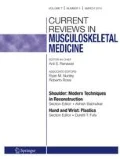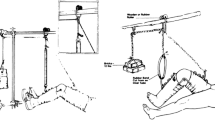Abstract
A variety of strategies are utilized for management of pediatric diaphyseal femur fractures, depending chiefly on the age of the patient. Other factors that can influence the selection of a technique—which range from skeletal traction with spica casting to immediate spica casting, flexible intramedullary nailing, rigid intramedullary rodding, or plate fixation—are weight, fracture severity, associated injuries, and underlying medical or musculoskeletal conditions. The available evidence regarding technique, outcomes, and complications of the aforementioned treatment options remains largely insufficient, and, at times, conflicting, which contributes to the challenges in management decisions. Considerable controversy has arisen over several topics, particularly the optimal treatment for patients aged 5 to 12 years and accepted standards of treatment. This review is designed to provide perspective for some of the most recent influential literature on pediatric diaphyseal femur fracture treatment in light of established evidence and evolving controversies.
Similar content being viewed by others
References
Papers of particular interest, published recently, have been highlighted as: • Of importance •• Of major importance
Heyworth B, Galano G, Vitale M, Vitale M. Management of closed femoral shaft fractures in children, ages 6 to 10: national practice patterns and emerging trends. J Pediatr Orthop. 2004;24(5):455–9.
Galano G, Vitale M, Kessler M, Hyman J, Vitale M. The most frequent traumatic orthopaedic injuries from a national pediatric inpatient population. J Pediatr Orthop. 2005;25(1):39–44.
Lodar R, O’Donnell P, Feinberg J. Epidemiology and mechanisms of femur fractures in children. J Pediatr Orthop. 2006;26(5):561–6.
Carey T, Galpin R. Flexible intramedullary nail fixation of pediatric femoral fractures. Clin Orthop Relat Res. 1996;332(11):110–8.
Flynn J, Hresko T, Reynolds R, Blasier R, Davidson R, Kasser J. Titanium elastic nails for pediatric femur fractures: a multicenter study of early results with analysis of complications. J Pediatr Orthop. 2001;21(1):4–8.
Mazda K, Khairouni A, Pennecot G, Bensahel H. Closed flexible intramedullary nailing of the femoral shaft fractures in children. J Pediatr Orthop. 1997;6(3):198–202.
Poolman R, Kocher M, Bhandari M. Pediatric femoral fractures: a systematic review of 2422 cases. J Orthop Trauma. 2006;20(9):648–54.
• Sink E, Faro F, Polousky J, Flynn K, Gralla J: Decreased complications of pediatric femur fractures with a change in management. J Pediatr Orthop 2010, 30(7):633–637. This paper showed that a decrease in the use of titanium elastic nails for unstable femur fractures and an increase in the use of submuscular plating between two time periods is accompanied by a decrease in major and minor complications in stable and unstable femur fracture management.
Narayanan U, Hyman J, Wainwright A, Rang M, Alman B. Complications of elastic stable intramedullary nail fixation of pediatric femoral fractures, and how to avoid them. J Pediatr Orthop. 2004;24(4):363–9.
Wall E, Jain V, Vora V, Mehlman C, Crawford A. Complications of titanium and stainless steel elastic nail fixation of pediatric femoral fractures. J Bone Joint Surg Am. 2008;90(6):1305–13.
Eidelman M, Ghrayeb N, Katzman A, Keren Y. Submuscular plating of femoral fractures in children: the importance of anatomic plate precontouring. J Pediatr Orthop B. 2010;19(5):424–7.
Hedequist D, Bishop J, Hresko T. Locking plate fixation for pediatric femur fractures. J Pediatr Orthop. 2008;28(1):6–9.
Kocher M, Sink E, Blasier R, Luhmann S, Mehlman C, Scher D, Matheney T, Sanders J, Watters 3rd W, Goldberg M, et al. Treatment of pediatric diaphyseal femur fractures. J Am Acad Orthop Surg. 2009;17(11):718–25.
•• Kocher M, Sink E, Blasier R, Luhmann S, Mehlman C, Scher D, Matheney T, Sanders J, Watters W, 3rd,, Goldberg M et al.: American Academy of Orthopaedic Surgeons clinical practice guideline on treatment of pediatric diaphyseal femur fracture. J Bone Joint Surg Am 2010, 92(8):1790–1792. The recent clinical practice guidelines stress the general lack of conclusive evidence available regarding treatment of pediatric femur fractures and the resulting inability to develop strong reccomendations for treatment guidelines.
Kanlic E, Anglen J, Smith D, Morgan S, Pesantez R. Advantages of submuscular bridge plating for complex pediatric femur fractures. Clin Orthop Relat Res. 2004;426(9):244–51.
Sink E, Hedequist D, Morgan S, Hresko T. Results and technique of unstable pediatric femoral fractures treated with submuscular bridge plating. J Pediatr Orthop. 2006;26(2):177–81.
Vanlaningham C, Schaller T, Wise C. Skeletal versus skin traction before definitive management of pediatric femur fractures: a comparison of patient narcotic requirements. J Pediatr Orthop. 2009;29(6):609–11.
Buckley SL. Current trends in the treatment of femoral shaft fractures in children and adolescents. Clin Orthop. 1997;60–73.
Buechsenschuetz KE, Mehlman CT, Shaw KJ, et al. Femoral shaft fractures in children: traction and casting versus elastic stable intramedullary nailing. J Trauma. 2002;53:914–21.
Frech-Dorfler M, Hasler C, Hacker F. Immediate hip spica for unstable femoral shaft fractures in preschool children: still an efficient and effective option. Eur J Pediatr Surg. 2010;20(1):18–23.
Salem K, Keppler P. Limb geometry after elastic stable nailing for pediatric femoral fractures. J Bone Joint Surg Am. 2010;92(6):1409–17.
• Sagan M, Datta J, Olney B, Lansford T, McIff T: Residual deformity after treatment of pediatric femur fractures with flexible titanium nails. J Pediatr Orthop 2010, 30(7):638–643. This article showed that malunion, specifically anterior bowing greater than 15°, is common following flexible titanium nailing of pediatric femur fractures. Additionally, it showed nail tip orientation to have a significant effect on mean deformations after nailing, with anterior pointing nail tips reducing the liklihood of anterior bowing.
Altay M, Erturk C, Cece H, Isikan U. Mini-open versus closed reduction in titanium elastic nailing of paediatric femoral shaft fractures: a comparative study. Acta Orthop Belg. 2011;77(2):211–7.
Shemshaki H, Mousavi H, Salehi G, Eshaghi M. Titanium elastic nailing versus hip spica cast in treatment of femoral-shaft fractures in children. J Orthop Traumatol. 2011;12(1):45–8.
Saseendar S, Menon J, Patro D. Treatment of femoral fractures in children: is titanium elastic nailing an improvement over hip spica casting? J Child Orthop. 2010;4(3):245–51.
Anastasopoulos J, Petratos D, Konstantoulakis C, Plakogiannis C, Matsinos G. Flexible intramedullary nailing in paediatric femoral shaft fractures. Injury. 2010;41(6):578–82.
Li YSK, Shilt JS. Biomechanical analysis of titanium elastic nail fixation in a pediatric femur fracture model. J Pediatr Orthop. 2008;28(8):874–8.
• Garner M, Bhat S, Khujanazarov I, Flynn J, Spiegel D: Fixation of length-stable femoral shaft fractures in heavier children: flexible nails vs rigid locked nails. J Pediatr Orthop 2011, 31(1):11–16.29. This article showed a decreased time in operating room, estimated blood loss, and implant-related problems, and no significant increase in complication rate for heavier pediatric femur fracture patients treated with titanium elastic nails compared to weight-matched patients treated with rigid locking nails.
Jencikova-Celerin L, Phillips J, Werk L, Wiltrout S, Nathanson I. Flexible interlocked nailing of pediatric femoral fractures: experience with a new flexible interlocking intramedullary nail compared with other fixation procedures. J Pediatr Orthop. 2008;28(8):864–73.
• Pate O, Hedequist D, Leong N, Hresko T: Implant removal after submuscular plating for pediatric femur fractures. J Pediatr Orthop 2009, 29(7):709–712. This article showed that leading plate edge bony overgrowth causes complications that lead to extensive plate removal procedures, and that timing of removal post union is not realated to difficulties during plate removal in pediatric femur frature patients treated with submuscular plating.
Barlas K, Beg H. Flexible intramedullary nailing versus external fixation of paediatric femoral fractures. Acta Orthop Belg. 2006;72:159–63.
Kempf I, Grosse A, Beck G. Closed Locked Intramedullary Nailing. J Bone Joint Surg Br. 1984;67-A(5):709–20.
Buford D, Christensen K, Weatherall P. Intramedullary nailing of femoral fractures in adolescents. Clin Orthop Relat Res. 1998;350(5):85–9.
Keeler K, Dart B, Luhmann S, Schoenecker P, Ortman M, Dobbs M, Gordon J. Antegrade intramedullary nailing of pediatric femoral fractures using an interlocking pediatric femoral nail and a lateral trochanteric entry point. J Pediatr Orthop. 2009;29(4):345–51.
Heideken J, Svensson T, Blomqvist P, Haglund-Akerlind Y, Janarv P. Incidence and trends in femur shaft fractures in Swedish children between 1987 and 2005. J Pediatr Orthop. 2011;31(5):512–9.
Disclosures
BE Heyworth: none; CA Suppan: none; DE Kramer: none; Y. Yen: consultant to Smith and Nephew Endoscopy, Orthopediatrics.
Author information
Authors and Affiliations
Corresponding author
Rights and permissions
About this article
Cite this article
Heyworth, B.E., Suppan, C.A., Kramer, D.E. et al. Management of pediatric diaphyseal femur fractures. Curr Rev Musculoskelet Med 5, 120–125 (2012). https://doi.org/10.1007/s12178-012-9112-4
Published:
Issue Date:
DOI: https://doi.org/10.1007/s12178-012-9112-4




